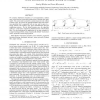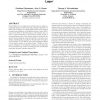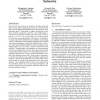1078 search results - page 87 / 216 » Optimal multiple-coverage of sensor networks |
ICASSP
2009
IEEE
2009
IEEE
Time-space-sequential algorithms for distributed Bayesian state estimation in serial sensor networks
14 years 3 months ago
We consider distributed estimation of a time-dependent, random state vector based on a generally nonlinear/non-Gaussian state-space model. The current state is sensed by a serial ...
SASN
2006
ACM
14 years 2 months ago
2006
ACM
Node misbehavior in wireless ad hoc networks leads to sudden unpredictable changes in network topology, resulting in fluctuation of traffic load and capacity for already existin...
MOBIHOC
2005
ACM
14 years 8 months ago
2005
ACM
Tiny, low-cost sensor devices are expected to be failure-prone and hence in many realistic deployment scenarios for sensor networks these nodes are deployed in higher than necessa...
ICC
2007
IEEE
14 years 3 months ago
2007
IEEE
—Slepian-Wolf coding is a promising distributed source coding technique that can completely remove the data redundancy caused by the spatially correlated observations in wireless...
SUTC
2008
IEEE
14 years 3 months ago
2008
IEEE
With the availability of low-cost sensor nodes there have been many standards developed to integrate and network these nodes to form a reliable network allowing many different typ...




